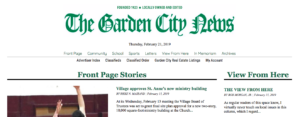 The New York Times reported last month on several incidents in which public officials revoked public notice contracts “in an effort to punish their hometown newspapers for aggressive coverage of local politics.” The story included two recent cases in New York state.
The New York Times reported last month on several incidents in which public officials revoked public notice contracts “in an effort to punish their hometown newspapers for aggressive coverage of local politics.” The story included two recent cases in New York state.
New York isn’t the only place where public officials sometimes seek to retaliate against those they perceive as enemies. But the state’s folkways and traditions, along with its arcane and antiquated public notice statutes, often result in the chaotic administration of the law.
PNRC creates ads promoting public notice
 PNRC has created a suite of print and web ads publicizing public notice. That’s one of the ads on the left.
PNRC has created a suite of print and web ads publicizing public notice. That’s one of the ads on the left.
The ad campaign promotes public notice advertising as vital local content that is available in newspapers and on newspaper websites.
The website aspect is crucial. While most readers are at least vaguely aware that government notices are published in newspapers, far fewer know they’re also posted on newspaper websites. The ad campaign, which includes banner ads and other formats suitable for the web or print, is designed to address that lack of awareness.
Self-storage industry tries something new
 The last time we checked in on the self-storage industry, it had helped pass new laws in four states relieving itself of the burden of informing its indebted customers via newspaper ads that it was about to sell their property. By some estimates, about 30 states have now enacted statutes providing self-storage operators with non-newspaper notice options that are woefully insufficient.
The last time we checked in on the self-storage industry, it had helped pass new laws in four states relieving itself of the burden of informing its indebted customers via newspaper ads that it was about to sell their property. By some estimates, about 30 states have now enacted statutes providing self-storage operators with non-newspaper notice options that are woefully insufficient.
The private-equity dominated industry is back this year with legislation in at least five states that would give it the option to jettison newspaper notice of lien sales.
NAM launches website linking statewide public notice sites
 Newspaper Association Managers, Inc., a consortium of North American associations and non-profit groups representing the newspaper industry, recently launched a website aimed at promoting public notice in newspapers. PNRC is a NAM member.
Newspaper Association Managers, Inc., a consortium of North American associations and non-profit groups representing the newspaper industry, recently launched a website aimed at promoting public notice in newspapers. PNRC is a NAM member.
The website, USALegalNotice.com, pulls together links to the 47 statewide public notice sites operated by state press associations. The site allows the public to more easily access the latest public notice advertisements in different states, including foreclosures, public hearings, financial reports, ordinances and resolutions, and other important government proceedings.
Connecticut courts move notices to government website
 The week before Christmas, Connecticut’s court system announced that as of Jan. 2, it would moving its notices from newspapers to a bare webpage on the Judicial Branch’s website. “It is expected that this will save a great deal of time and expense, and provide greater accuracy and broader notice than newspaper publication,” the judicial branch said in a statement posted on its website.
The week before Christmas, Connecticut’s court system announced that as of Jan. 2, it would moving its notices from newspapers to a bare webpage on the Judicial Branch’s website. “It is expected that this will save a great deal of time and expense, and provide greater accuracy and broader notice than newspaper publication,” the judicial branch said in a statement posted on its website.
Connecticut courts are not required by state statute to publish notices in print, but until last month they relied on newspapers to satisfy their notice requirements, said Chris VandeHoef, executive director of the Connecticut Daily Newspapers Association.
Why we call it “public notice”
 Statutorily required notice goes by a number of different names. There’s “public notice”, of course. “Legal notice” is a big one. “Legal ads” is also used quite often. And then there’s plain old “legals”, as in “the legals”.
Statutorily required notice goes by a number of different names. There’s “public notice”, of course. “Legal notice” is a big one. “Legal ads” is also used quite often. And then there’s plain old “legals”, as in “the legals”.
Ask someone in the newspaper business what they’re called and you may get any one of those answers. Ask someone outside the newspaper business the same question and the response is likely to be, “Huh?”
There are a number of reasons for the public confusion over public notice advertising, including the fact that the newspaper industry can’t agree on a name for them. Branding 101 would suggest that’s a problem.
Missouri papers take the offensive; unusual notice bills introduced in Idaho and West Virginia
 Newspapers in Missouri are going on the offensive in their battle to save public notice in their state.
Newspapers in Missouri are going on the offensive in their battle to save public notice in their state.
Fighting separate bills that would move all government and foreclosure notice in the state from newspapers to government and law-firm websites, the Missouri Press Association (MPA) threw its support behind Senate Bill 515, introduced last week on the final day for filing new legislation in Jefferson City. SB 515 would require newspapers in the state that publish notices to also post them on MPA’s statewide public notice site. It would also limit rates by requiring newspapers to include volume or repeat-buyer discounts, and by mandating lower prices for “second and successive insertions”.
City pulls notices after critical coverage
 A New York Times story reports on a move by the Garden City, N.Y. village board to take public notices out of a local newspaper and start running them in a smaller competitor.
A New York Times story reports on a move by the Garden City, N.Y. village board to take public notices out of a local newspaper and start running them in a smaller competitor.
It’s the latest attempt by government officials to use economic pressure to try to sway coverage.
Meg Morgan Norris, editor and publisher of the 8,300-circulation Garden City News, has been critical of the village board’s handling of the redevelopment of a local landmark.
In addition to cutting the notices, the village board also has threatened to stop sending news items like calendar listings and senior columns to the News.
Poor Customer Service Sabotages Newspaper Notice
 When the Air Quality Division of the Indiana Department of Environmental Management (IDEM) announced a proposal last year to move all of its public notice advertising from newspapers to its own website, its motivation for doing so was clear: Bureaucratic efficiency.
When the Air Quality Division of the Indiana Department of Environmental Management (IDEM) announced a proposal last year to move all of its public notice advertising from newspapers to its own website, its motivation for doing so was clear: Bureaucratic efficiency.
“(IDEM’s) proposal never even bothers to claim e-notice will reach more Indiana citizens,” PNRC noted in the comments we filed opposing the plan. “It focuses instead on cost, convenience and expedience. Those are all worthy goals. Unfortunately, none are the primary purpose of public notice laws.”
More Newspapers Should Do This
 The Indianapolis Star published a story today about the Indiana Department of Environmental Management (IDEM) proposal to move the notices it is required to publish under the Clean Air Act from newspapers to its lightly visited website. The article by Emily Hopkins and Sarah Bowman may be the best reporting we’ve ever seen squarely addressing the subject of whether public notice belongs in newspapers or on government websites. In fact, it may be the only reporting we’ve ever seen on that issue.
The Indianapolis Star published a story today about the Indiana Department of Environmental Management (IDEM) proposal to move the notices it is required to publish under the Clean Air Act from newspapers to its lightly visited website. The article by Emily Hopkins and Sarah Bowman may be the best reporting we’ve ever seen squarely addressing the subject of whether public notice belongs in newspapers or on government websites. In fact, it may be the only reporting we’ve ever seen on that issue.
